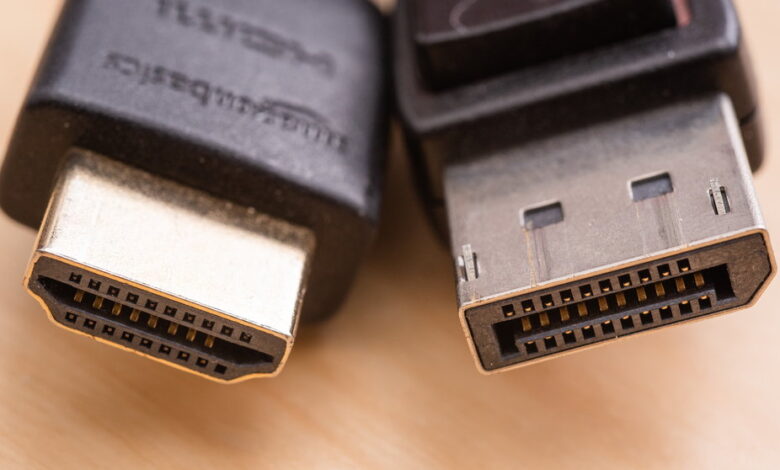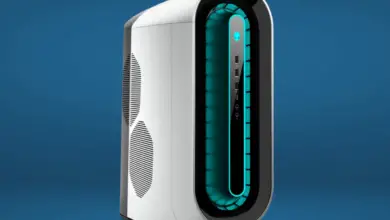Which Port should we use on a gaming PC: DisplayPort or HDMI?

Modern personal computers can generate a lot of content. To display this content on computer monitors or TVs, we need screen interfaces. These interfaces are standardized standards that transmit video and audio content.
The most commonly used ports for connecting personal computers to display screens are DisplayPort and HDMI. Recently, the versatile USB Type C has also become popular, with special modes that support previous technologies. All of these ports have multiple uses, but which one is best for a gaming PC? We’ll answer this question by analyzing the features and advantages of each interface.
Display Port
DisplayPort was introduced as the most recent major display interface standard in 2008 by the VESA organization. Its main purpose is to transmit content, including video, audio, and data, between a PC and one or multiple monitors. The connector of DisplayPort has 20 pins (32 in internal connectors for laptops) and features a small mechanism to ensure a secure fit in devices. You may come across full-size or reduced-size connectors, also known as Mini DisplayPort (MiniDP or mDP), which offer the same functionality.
Currently, the most commonly used versions of DisplayPort are 1.3 and 1.4, providing a bandwidth of up to 32.4 Gbps. This high bandwidth allows for native screen resolutions up to 8K, with a resolution of 7,680 x 4,320 pixels. The audio signal supported by DisplayPort can handle a maximum of 8 uncompressed channels, with a sampling rate of 192 kHz and a bit depth of 24 bits. Additionally, DisplayPort supports optional Digital Restrictions (DPCP) with 128-bit AES encryption and has been compatible with the widely used digital content protection standard, HDCP, since revision 1.1.

DisplayPort has different maximum supported video frequencies depending on the version. All versions support 144 Hz at 1080p resolution. Version 1.2 supports 144 Hz at 2K resolutions. Version 1.3 can handle up to 120 Hz at 4K or 8K with a refresh rate of 30 Hz. Version 1.4 enables a refresh rate of 144 Hz in 4K through Display Stream Compression (DSC), and it supports up to 60 Hz at 8K resolution with HDR.
The latest version of the DisplayPort standard is DisplayPort 2.0. This version significantly increases the bandwidth to an impressive 77.37 Gbps. It supports refresh rates of 144 Hz in 4K, raises the refresh rate for 8K to 120 Hz, and introduces support for 16K resolution (at 30 Hz), which HDMI does not yet support. DisplayPort 2.0 is currently the most advanced screen interface available in the industry, although its adoption is not yet widespread.
HDMI
The High-Definition Multimedia Interface (HDMI) is an industry-standard that was introduced in 2002 as a replacement for the older scart connector. It allows for the transmission of uncompressed, encrypted, high-definition video and uncompressed multi-channel audio through a single cable. HDMI offers several advantages, including features like HDMI-CEC (HDMI Consumer Electronics Control), which enables the control of multiple devices with a single remote. Its primary focus extends beyond PC use and is the preferred interface for connecting multimedia devices to large screens, such as televisions.
The standard HDMI connector, known as Type A, consists of 19 pins. There is also a Type B connector with 29 pins, which supports an expanded video channel for high-resolution displays. HDMI connectors are available in full size (Type A), as well as smaller variants with the same features, known as mini-HDMI (Type B) and micro-HDMI (Type C). One of the clear advantages of HDMI is its widespread adoption, as it can be found on various types of devices.
However, there are a few disadvantages to consider. The HDMI connector is generally less sturdy compared to previous screen standards like VGA, making it more prone to accidental disconnections and potential physical or electrical failures. Additionally, there has been criticism regarding the inclusion of digital content protection (HDCP), which manages “digital restrictions” and prevents users from copying transmitted content.

Since its introduction, HDMI has undergone several revisions. The most widely used versions at present are 1.4 and 2.0. These versions addressed the bandwidth limitations of previous iterations, achieving data transfer rates of up to 18 Gbps/s, which enables 60 FPS in 4K resolution and 144 Hz in 1080p resolution. HDMI 2.0 also introduced significant improvements in other areas, such as support for high dynamic range (HDR) and increased color depth up to 10 and 12 bits. The advantage is that HDMI 2.0 remains compatible with previous versions at the wiring level, allowing users to benefit from its features using older cables.
HDMI 2.1 is the most recent major version of the standard and represents a significant milestone. It offers a substantial increase in maximum bandwidth, reaching up to 48 Gbps/s. This enables support for resolutions up to 8K and 10K at 60Hz, as well as 120Hz refresh rate in 4K. Additionally, HDMI 2.1 introduces dynamic HDR support across all resolutions and includes features like variable refresh rate, enhanced audio return (eARC), and support for Dolby Atmos and DTS:X audio formats. Despite being announced in 2017, the widespread adoption of HDMI 2.1 has been limited, although most mid-range and higher-end monitors released in 2023 support this version.
It is worth mentioning that a new revision called HDMI 2.1a has been announced. It introduces a new feature called Source Based Tone Mapping (SBTM), which enhances HDR dynamic range technology. SBTM allows the video source, such as a PC or game console, to handle HDR tone mapping on a display screen like a monitor or television. This feature is particularly relevant for gaming, as it enables devices to combine HDR, SDR, and dynamic HDR graphics to create visually compelling images as intended by game developers.

Choosing Between DisplayPort and HDMI for PC Gaming
The latest versions of both DisplayPort and HDMI are highly advanced, catering to the needs of most consumers. Graphics cards, whether dedicated or integrated, offer outputs for both interfaces, while modern monitors are equipped with corresponding inputs. High-end monitors support the most advanced versions of these interfaces. Various types of cables and adapters are available to convert between the two, but using adapters may result in some loss of benefits.
When it comes to gaming PCs, there is no doubt that DisplayPort is the top choice and the preferred port for gamers. While HDMI 2.1 has made significant progress in terms of features, it still falls behind DisplayPort in several aspects, such as bandwidth and supported resolution.

Additionally, if you are using an NVIDIA graphics card and have a monitor that supports the proprietary G-Sync image synchronization technology, the choice becomes even clearer in favor of DisplayPort. This is because NVIDIA does not support HDMI for G-Sync setups.
The same applies if you plan to set up a multi-screen configuration. DisplayPort stands out from other interfaces as one of its advantages is the ability to output video content to multiple displays using Multi-Stream Transport (MST) technology. DisplayPort can be “split” through hubs and displays can be connected in a daisy chain fashion. HDMI lacks this capability due to its concept and design.
In summary, when it comes to gaming PCs, DisplayPort should be the preferred interface. It is specifically designed for personal computers and offers more advanced features and possibilities compared to HDMI, which is more suitable for connecting multimedia devices to larger screens like televisions or video game consoles when DisplayPort is unavailable.



